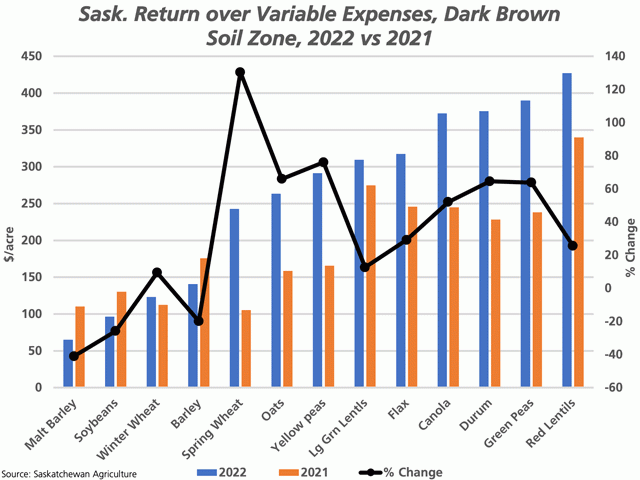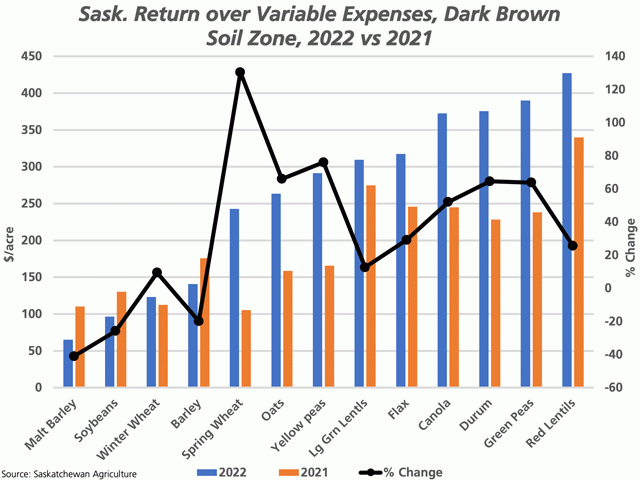Canada Markets
Saskatchewan Agriculture's 2022 Crop Planning Guide
Saskatchewan Agriculture's Crop Planning Guide estimates both the costs and returns for 30 crops grown across Saskatchewan's three soil zones. Calculations made by the government are based on the inputs and returns with targeted yield that is at the 80th percentile for each crop in each soil zone, averaged over five years.
While many assumptions are made, the government also provides a spreadsheet available for download that allows producers to enter their own farm data. Results may or may not have an effect on seeding intentions, with factors such as soil moisture, input availability and crop rotations also playing a major role in the decision- making process.
Here are a few observations on the data presented in the 2022 report, with a focus on the return over variable expenses for the three soil zones.
The brown soil zone shows the largest number of crops analyzed, with 22 reported in total. This includes brown, yellow, and oriental mustard, desi chickpeas, two sizes of kabuli chickpeas, and small specialty crops such as fenugreek and camelina that are not included for the dark brown or black soil zones.
Of the crops analyzed, corn is the only crop where the government tables show a negative return over variable costs, at minus $54.92/acre. Crops showing modest returns include fall rye at $2.71/acre, soybeans at $32.96/acre, and malt barley at $40.86/acre. The largest return calculated is kabuli chickpeas (large) at $527.76/acre, which is the second-highest return of all cropping options analyzed across the province, next to quinoa grown in the black soil zone, with the return above variable expenses shown at $549.70/acre.
P[L1] D[0x0] M[300x250] OOP[F] ADUNIT[] T[]
Of the largest crops, the feed barley return is $113.14/acre, oats at $141.19/acre, spring wheat at $183.61/acre, durum at $300.15/acre and canola at $328.13/acre.
The report also includes a sensitivity analysis that shows the return if expenses were left unchanged while yield was revised lower to an average level. This analysis results in four additional crops falling into negative territory, which would be viewed as the riskiest crops to grow, based on the assumptions made. These include fall rye (minus $49.17/acre), soybeans (minus $26.05/acre), malt barley (minus $41.87/acre) and kabuli chickpeas, small (minus $24.68/acre).
Returns for the 19 crops reported for the dark brown soil zone shows corn as the only crop where the analysis leads to a negative return over variable costs at $21.61/acre, while the highest return reported for the soil zone is $447.08/acre for oilseed sunflowers.
Of the largest crops, the barley return is shown at $140.83/acre, spring wheat at $242.87/acre, oats at $263.33/acre, canola at $372.61/acre and durum at $375.45/acre.
The brown bars on the attached chart represents the returns shown in the 2021 planning guide, released one year ago. Of the select crops shown, the calculated returns for malt barley, feed barley and soybeans are reported lower for 2022 than 2021, with the largest drop seen in malt barley, where the return over variable expenses is reported 41% lower for 2022, as seen with the black line with markers against the secondary vertical axis. At the same time, the largest year-over-year change is seen for spring wheat, with the calculated return up 130.4% for 2022 to $242.87/acre. Note that the government calculations are for spring wheat in the 2021 report and hard red spring wheat in the 2022 report.
The report's yield sensitivity calculation for the dark brown soil zone results in fall rye joining corn with a negative return above variable expenses when average yields are modeled, while the malt barley return falls to just $0.69/acre and the soybean return falls to a modest $13.03/acre.
Data for the black soil zone shows all 17 crops modelled showing a positive return over variable expenses, ranging from $33.63/acre for corn and $549.70/acre for the small acreage of quinoa grown.
Returns for the largest crops show the barley return at $152.32/acre, spring wheat at $282.86/acre, canola at $410.19/acre and oats at $445.12/acre.
The yield sensitivity analysis results in the return for corn moving to a loss of $32.62/acre. All other crops are forecast to maintain a positive return above variable expenses when yield falls to average levels.
Cliff Jamieson can be reached at cliff.jamieson@dtn.com
Follow him on Twitter @Cliff Jamieson
(c) Copyright 2022 DTN, LLC. All rights reserved.





Comments
To comment, please Log In or Join our Community .